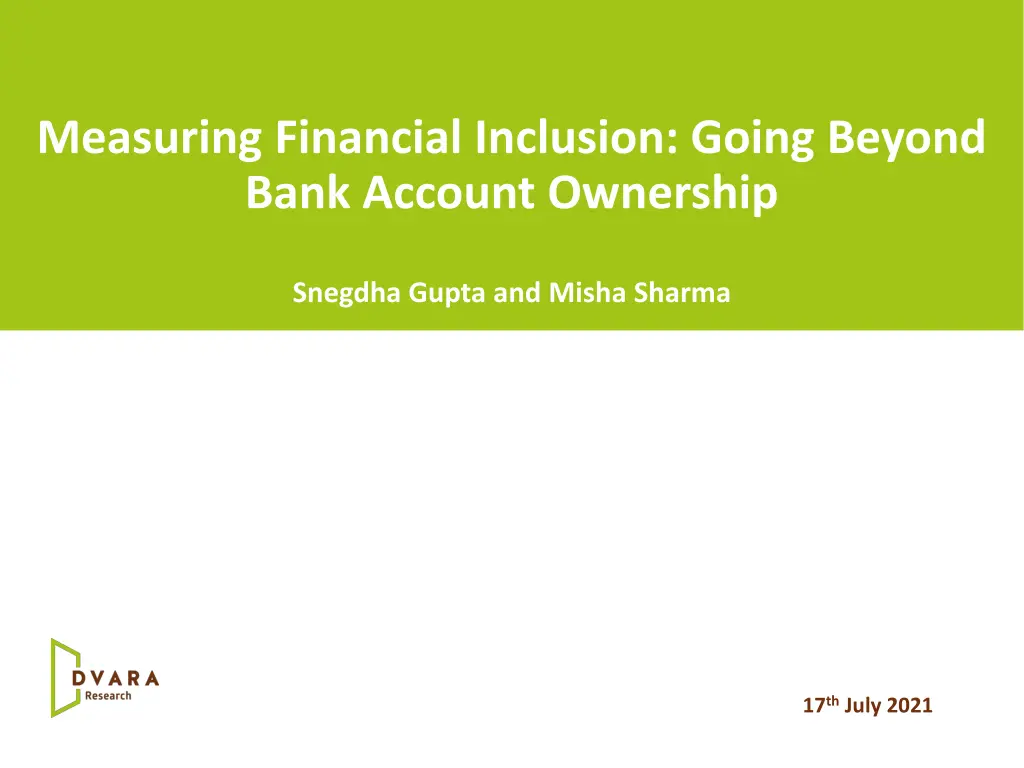
Measuring Financial Inclusion Beyond Accounts
"Learn about measuring financial inclusion beyond bank accounts to include access to various financial services. Explore a composite index for Indian households, uncover geographies with lower inclusion levels, and compare rural and urban performance. Delve into state rankings and dimensions influencing financial inclusion scores."
Download Presentation

Please find below an Image/Link to download the presentation.
The content on the website is provided AS IS for your information and personal use only. It may not be sold, licensed, or shared on other websites without obtaining consent from the author. If you encounter any issues during the download, it is possible that the publisher has removed the file from their server.
You are allowed to download the files provided on this website for personal or commercial use, subject to the condition that they are used lawfully. All files are the property of their respective owners.
The content on the website is provided AS IS for your information and personal use only. It may not be sold, licensed, or shared on other websites without obtaining consent from the author.
E N D
Presentation Transcript
Measuring Financial Inclusion: Going Beyond Bank Account Ownership Snegdha Gupta and Misha Sharma 17th July 2021
Research Context Gaps in existing measures of financial inclusion that view financial inclusion as a one- dimensional concept Measurement of financial inclusion often gets restricted to bank account ownership or access to credit Financial inclusion instead is about access to and usage of a range of financial products to meet varied financial needs throughout the lifecycle of a household/individual Applying this concept, we create a Composite demand-side financial inclusion index (Composite-FII) that measures the levels of access to and usage of formal financial services among Indian households Ultimate objective of the paper is to identify geographies with lower levels of financial inclusion and products that need greater take-up 2
Inputs to Financial Inclusion Index Source: CMIE-CPHS, 2019 Composite demand-side financial inclusion index that measures the levels of access and usage of formal financial services among rural and urban households Access Usage Saved atleast once in the last one year in risk-free product Saved at least once in the last one year in risky product Saved at least once in the last one year in life insurance Bank account Health Insurance Life Insurance Saved at least once in the last one year in provident fund Borrowed at least once in the last one year Provident Fund O/S saving/investment in at least one risk-free product O/S saving/investment in at least one risky product Outstanding Debt from Formal Sources Notes: Data source for analysis- CMIE Household Survey, 2019 Risk-free product includes Fixed deposits, Post office savings, National savings certificate, Kisan Vikas Patra Risky product includes demat account, mutual funds and shares 3
Research Questions Are there differences in the levels of financial inclusion when measured through the composite index versus the bank-based index? Do rural geographies have lower levels of access to and usage of formal financial services compared to urban geographies at an all-India level? Are there differences in states performance levels of attainment of financial inclusion by rural versus urban regions? Are there differences in states ranking of financial inclusion as per the demand- side versus the supply-side index? Across various dimensions of financial inclusion, are there dimensions that play a larger role in influencing the overall financial inclusion score? 4
Bank-based versus Composite Financial Inclusion Index Bank FII scores for all-India-urban is 0.81, while the Composite-FII score for the same region is 0.61 Bank-FII scores for all-India-rural is 0.84 compared to the Composite-FII score of 0.55, for the same region Median and range of Bank-FII scores both in urban and rural geographies is higher than the Composite-FII scores 5
Access and Usage Score by Composite FII Access score is higher than usage score in rural region For urban geographies, the range of values is marginally lower for the access score compared to the usage score, although the median is the same 6
State-wise Performance by Composite-FII In the case of urban geographies, Punjab and Assam have the highest score while Uttar Pradesh, Bihar, Jharkhand and Madhya Pradesh have the lowest score. In the case of rural geographies, Himachal Pradesh and Haryana have the highest score, while Maharashtra and Uttar Pradesh have the lowest score. 7
Best vs. Worst States by Composite FII States that perform poorly both in rural and urban geographies are MH, UP, GJ and MP States that perform well in both the regions are Tripura, HP, Odisha, RJ, J&K and Goa 8
Comparison with Supply Side CRISIL Index The rank correlation coefficient between the composite FII-rural and CRISIL s Inclusix is 0.13, whereas the rank correlation coefficient between the composite FII-urban and Inclusix is slightly higher at 0.23. As per Inclusix 2018, the southern states feature in the top 5 rankings, whereas these states don t feature in the top five ranking (barring urban Telangana) either in the urban Composite-FII score or rural Composite-FII score Three states that consistently receive very poor ranking across Composite-FII-urban, Composite-FII-rural and Inclusix are Gujarat, Uttar Pradesh and Maharashtra and therefore require targeted efforts in accelerating financial inclusion. Overall, our results suggest that the supply of formal financial services is not a strong predictor of demand for these services and that there are other factors influencing demand for formal finance. 9
Appendix- Index Methodology There are n dimensions of financial inclusion index (FII) where n is greater or equal to 1 Each dimension refers to a functioning of the financial service in question Let xi denote the level of attainment of a particular state in dimension i The lower and upper bounds of xi are denoted by mi and Mi respectively (mi < Mi) We measure A(xi, mi, Mi), the indicator of performance of the state in question in terms of dimension i using the following function: where, i=1,2, ,n; r is a constant such that 0<r<1 A is continuous in its arguments and r is the inclusion sensitivity parameter such that A increases as r decreases for given values of xi, mi and Mi. Next, we compute FII by averaging the individual indicators as given by (1):


